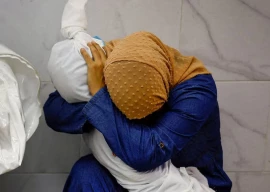
BAHAWALPUR:
Darawar Fort in Cholistan desert is the victim of broken promises.
The ancient structure, rebuilt in 1733 by the Nawab of Bahawalpur, is an archetype of magnificence gone to ruin. Imdad Ali, a 50-year-old native of the area explains how the fort is synonymous with the history and the landscape of the region – a part of the community’s collective consciousness.
Many politicians have visited the fort over the years, says Ali, and vowed to restore the structure to its original grandeur. But their promises have remained empty words. Ali, who has heard stories about Darawar Fort since he was seven from his forefathers, adds that a lack of development in the area means migration away from the surrounding region has been rampant. With the canal system also destroyed over the years, Darawar fast appears to be approaching extinction.
A tiny population surrounding the fort, a total of 3,000 people, still has some hope. While the historical building itself crumbles, the area, which is the constituency of MNA Chaudhry Saud Majeed, finally has had renovation work on its main road.
Majeed, while talking to The Express Tribune said that he had met with Secretary Allah Baksh to discuss the restoration of the fort and had allocated a certain budget to its maintenance. Majeed also said that a letter had been sent to the United Nations Educational, Scientific and Cultural Organisation (UNESCO) in this regard and a ‘positive response’ had been received.
Whether all of this will translate into urgent renovation and maintenance work which the fort desperately needs, however, is a separate matter.
A time comes, every year, when Darawar Fort becomes a connecting point for the past and the present. Located around 75 kilometres from Bahawalpur, Darawar is a starting point for a desert jeep rally attended by close to 70,000 people annually. Many of the participants at the last rally voiced the same concern – who’s going to save Darawar?
An inside tour of the structure indicates how necessary funds are to maintain a national treasure. Special permission from the Nawab of Bahawalpur is needed to visit the building, adjacent to which lies a mosque and a generations-old graveyard of the Nawab’s family.
When one looks out from the wall of the fort, the beauty of the entire Cholistan desert is visible.
Inside on the other hand, the view tells a different story. The walls are visibly damaged, the woodwork falling apart. Its future seems as dark as its past – Darawar was also used to house prisoners, and simultaneously served as the location where some of the more unlucky inmates would be hanged. The building also consists of a vast network of underground tunnels.
The adjacent graveyard holds as much capacity for legend as the fortress itself. It is said that the graves of four of the Holy Prophet’s (pbuh) companions are located there. Many of the remaining graves belong to members of the Nawab of Bahawalpur’s family.
What remains to be seen, however, is whether Darawar will one day find itself crumbling in the dust like the residents of the nearby cemetery if its renovation continues to be delayed.
Published in The Express Tribune, February 8th, 2012.

































































COMMENTS
Comments are moderated and generally will be posted if they are on-topic and not abusive.
For more information, please see our Comments FAQ